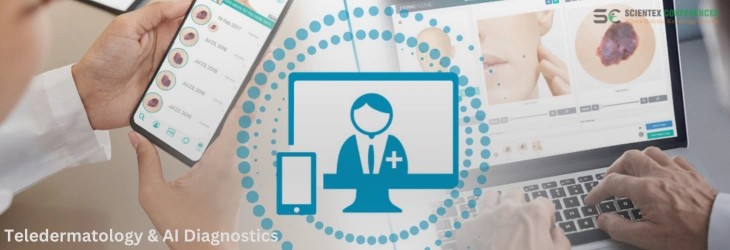Track: Teledermatology & AI Diagnostics

This cutting-edge session explores how teledermatology and artificial intelligence (AI) are redefining the delivery and accuracy of dermatologic care across the globe. As technology becomes an integral part of clinical practice, the dermatology community is witnessing a profound transformation—from virtual consultations and AI-assisted skin lesion analysis to mobile-based triage systems and real-time decision support tools. This session will provide a comprehensive understanding of how these innovations are being implemented, evaluated, and integrated into modern dermatology workflows, enhancing both accessibility and precision.
Participants will gain actionable insights into:
Implementing teledermatology services for various settings (hospital, clinic, rural outreach). Leveraging AI algorithms for diagnosis, triage, and risk assessment. Addressing ethical, legal, and clinical challenges that accompany this digital shift.
Foundations of Teledermatology:
Teledermatology, a rapidly evolving field, encompasses various models such as store-and-forward, real-time video consultations, and hybrid approaches that combine both methods. These models support diverse clinical workflows, beginning with image acquisition and extending to the seamless integration of data into electronic health records (EHRs). Ensuring quality assurance and the standardization of photographic documentation is essential for accurate diagnosis and continuity of care. Teledermatology has proven especially beneficial in the management of chronic skin conditions like psoriasis, acne, and eczema, as well as in addressing skin infections and providing effective wound care.
Role of AI in Dermatologic Diagnosis:
Deep learning, particularly through convolutional neural networks (CNNs), has revolutionized dermatological diagnostics by enabling automated, high-accuracy image analysis. These technologies are widely applied in skin cancer detection, including melanoma, basal cell carcinoma (BCC), and squamous cell carcinoma (SCC), offering diagnostic support comparable to that of experienced dermatologists. CNNs also facilitate automated acne grading and treatment monitoring, and are increasingly used to assess pigmentation disorders and analyze psoriasis severity. Clinical trials have validated many AI tools, demonstrating performance on par with dermatologists. However, to ensure equitable care, it is critical to address biases in training datasets, particularly concerning skin tone diversity, age variations, and underrepresented or rare skin disorders.
Integration into Practice:
Implementing teledermatology effectively requires the selection of secure, reliable platforms that ensure confidentiality and data integrity during consultations. Integrating AI tools into electronic medical records (EMRs) and patient management systems further enhances diagnostic accuracy and workflow efficiency. However, these advancements must be carefully balanced with medico-legal considerations, including strict adherence to data privacy regulations such as HIPAA and GDPR, addressing liability concerns, and obtaining informed patient consent. Additionally, understanding billing structures, reimbursement models, and insurance acceptance for virtual services is essential for the financial sustainability and widespread adoption of teledermatology practices.
Public Health & Accessibility:
Teledermatology plays a vital role in expanding dermatologic care to rural, low-income, and medically underserved populations by overcoming geographic and infrastructural barriers. National teledermatology programs in regions such as India, Africa, and Latin America have demonstrated success through scalable models that leverage existing technologies. The use of smartphone applications combined with dermatoscope attachments enables frontline care workers to capture high-quality images and transmit them for expert evaluation, even from remote locations. These mobile diagnostic solutions help close the care gap by facilitating timely consultations, early detection of skin conditions, and improved patient outcomes in environments with limited access to specialist care.
Future of Dermatology in a Digital Age:
Advancements in artificial intelligence have introduced predictive analytics that can forecast individual treatment responses, allowing for more personalized and effective dermatologic care. Chatbots and virtual assistants are increasingly used for initial symptom checking, triage, and follow-up care, enhancing patient engagement and reducing the burden on clinical staff. Augmented reality (AR) and virtual reality (VR) technologies are transforming medical education and patient counseling by providing immersive, interactive learning experiences and improving understanding of complex skin conditions. As these innovations become more integrated into clinical practice, emerging standards in AI regulation and certification are essential to ensure the safety, efficacy, and ethical use of dermatologic tools.
Interactive Elements:
AI Diagnostic Simulation Lab:
Compare your clinical judgment with AI-generated results using anonymized patient images of skin lesions and rashes. Engage in collaborative voting and outcome discussion.
Teledermatology Workflow Demonstration:
Live walkthrough showing best practices in photographing skin conditions, conducting virtual assessments, and integrating patient feedback tools.
Expert Fireside Chat:
Topic: “Dermatology Without Borders: Can AI and Telemedicine Redefine Global Skin Health?” – A conversation between dermatologists, ethicists, and digital health pioneers.
Tech Demos & Startup Spotlights:
Explore booths or virtual corners showcasing the latest AI-powered dermatoscopes, mobile derm apps, imaging software, and teleconsultation tools.
Scientific Highlights
- Skin Diseases: Acne, Psoriasis, Dermatitis
- Cosmetic Surgery
- Dermatopathology
- Pediatric Dermatology
- Facelift (Rhytidectomy)
- Aesthetic Medicine
- Plastic Surgery
- Diet & Nutritional Supplements for Healthy Skin
- Oral and Maxillofacial Surgery
- Dermato oncology
- Dermatology
- Trichology and Hair Transplantation
- Vitiligo Treatment
- Rhinoplasty and Otoplasty
- Fungal Skin Infections
- Cosmetology
- Skincare Treatment
- Dermatologic Disorders
- Clinical Trial and Case Reports
- Teledermatology & AI Diagnostics
- Wound Care
- Leprosy in Modern Dermatology
- Onychomycosis
- Regenerative Aesthetics
- Targeted Drug Delivery Systems
- GI Health & Skin


